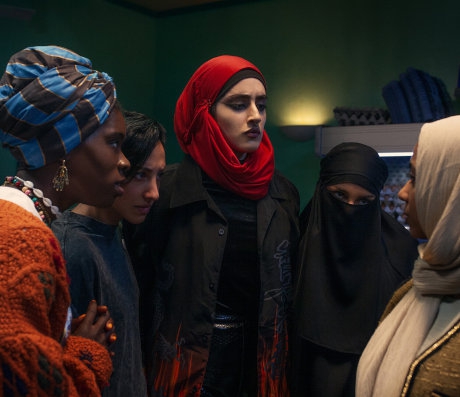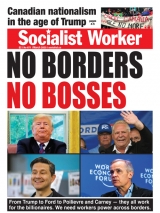Arts
You are here
Muslim women, punk rock, and liberation

July 4, 2021
There is a new phenomenon of what feminist theorist Rebecca Wanzo has called the “precarious-girl comedy” where the intimate problems of modern women are often accompanied by unsubtle foregrounding of or the atmospheric background of suffering in a competitive market. Most of these women who are protagonists in this new kind of comedy-drama are struggling to find a job, employed in gig-economy sectors or are in between jobs – or are working class women doing three jobs at the same time.
The alienation in their work translates into their romantic life: often the central premise of most of these shows has a woman trying to find love while finding a stable career, rent an apartment, and have enough to pay for food. The central contradictions of most of these shows is precisely the competition one faces in the job-market and the neoliberal insularity one faces in intimate life.
The imagined resolutions for this struggle make up the storylines of the show. They often turn into solidarity plotlines, where women find each other through their shared struggles, or they slip into sentimental, individualist “success” narratives where the women choose either love or a job – or show how they are successful in managing both. Initially these shows overwhelmingly were and still are about white women (like Fleabag), but now with shows like Insecure and Chewing Gum to name a few, race and gender is taken into account while navigating the crisis-prone economic conditions we live in.
Indeed, the genre of “precarious-girl comedy” is itself a sign of our times, where feminist struggles against oppression cannot be separated from liberation from exploitative regimes. While these shows are about “unlikable” women trying to find a place in the world, their unlikeability is steeped in emergent contestations against both conservative and reformist tendencies of the times: these women are not satisfied by the current solutions to their problems. They want more, and so they aren’t particularly likeable to many who are okay with how things are or cannot envision transformation without multiple compromises.
We are Lady Parts (2021), a British comedy-drama directed by Nida Manzoor, follows this development of “precarious girl-comedy” featuring Muslim women struggling to find a place of their own in the overwhemingly immigrant neighborhood of East London.
We see them channeling their creative energies and rage by trying to establish a punk band. At the first glance the show seems to “check-listing” each and every identity-categories possible: Black, south asian, middle-eastern and British. But then it does manage to proffer that “representation”, which is also a important concept within the show, doesn't come without a cost and having every identity “on board” isn’t enough. Although it isn’t trumpeted loudly in their shock-effect ridden punk rock songs, it is expressed in how all the women are not only part of a punk band, but are employed precariously. One of them is a struggling PhD student, one drives an Uber, one is employed in a butcher shop, another one in a lingerie store whilst another tries to sell zines in art markets. All of them have a dream of making it “big” through the punk band, but that is not what brings them to make the band---it is a place where their conflict-ridden lives could find a place of sisterhood and solidarity.
The women lead lives which are rife with contradictions: Amina is a religious woman trying to find her match alongside her religious friends who are already hitched or are on their way to, but her parents are far from religious. Saira is alienated from her religious family and struggles to be in a heteronormative relationship with a man who wants to marry her. Ayesha is a queer Muslim woman who is troubled by her brown, influencer girlfriend’s questioning of her Muslimness. Momtaz wears a Niqab throughout the show while her job is to sell lingerie. Bisma is a Black Muslim mother which presents its own conflicts in a racist and xenophobic society.
In the band, they sing songs about their Muslim identity, their struggles with living in a patriarchal society whilst all the while, trying to get a place to perform at as no one wants to give them one to do so. The contradictions I have pointed out do pain them, but they do not take precedence over building a world where they could seek moments of uncomplicated companionship and comradeship. Utilisation of the trope of trying to make a band while playing as Muslim women isn’t reduced to contradictions of practising religion and pursuing art, or being progressive or traditional; these questions are instead subsumed as faultlines in a larger universe of struggles to make a living in a world that breaks you for who you are, all the while extracting time out of your life to pay for (a) living. A scene that stuck with me is how Ayesha meets the women while not leaving work, in an Uber, to plan their next steps for the band. It might be a pretty innocent and a basic transition scene, however the simultaenity of inability to get out of work to discuss art lest one loses pay, while being seen as a Muslim woman driving a car in a hijab by her passengers, expresses the exhausting macro structures impeding just surviving the everyday.
The choice of punk does not seem forced and ties in very well with the social struggles these women embody. The history of punk rock, if one draws a timeline from its emergence in the 1970s, has always been tied to the angst and anger of those who reject oppressive traditions. The history however also sees a criss-crossing with predominantly white, middle-class and upper class tendencies of negating living in an authoritarian society writ-large, express anarchy in their aesthetics and irreverence towards having a coherent political stance--- thus signifying rebellion and pseudo-rage without any real ground, intention or vision for social change in sight.
However, it is not the songs or the anarchical aesthetics of punk that matter. But what it expresses about the prevalent societal contradictions itself. Punk, for all its reactionary history, has had a critical realism to its aesthetics. Social struggles are made unsubtly aware of through not only its music, but how refuge is sought in the DIY subcultural tradition of punk.
Similarly, in We Are Lady Parts, there is a constant tension between turning into the tunes of the dominant culture of influencer-based industry or struggling to change the way music is done and distributed---making the audience realise that the music industry, like any other, might be producing progressive tunes but doesn’t function in an equitable economic apparatus.
The obvious dependence on internet-based audiences to be recognised crashes into crisis when their “Muslimness” is questioned by the anonymous audience of the internet. However, the same internet seems to give them a group of people trying to find a subcultural space where their struggles are talked of or sung about because their everyday life doesn’t seem to provide them with any resolution. The temporary and symbolic relief and mediation of pressing life-issues sought in the music thus projects the collective need and indeed, absence of relief from oppression and exploitation in everyday life. They know their problems won't be solved by their music, but that's not their intention either--- their music is a way of communicating the struggles they have identified as primary to them.
In the end, the women end up playing in an empty garage-like place, expressing how the industrial standards and corporatisation of music can never really build a truly liberating commons and one has to find their own counterspaces to struggle against and survive the dominant conditions. Thus, the fragility of sticking to “representation” without taking account of the unequal economic conditions through which representation is sought, is thrown open in the last few episodes. Representation is not then about being “seen” alone, but being heard, where the echoes of needing solidarity and a commons is not only in their songs, but why and and how they end up on the stage in the first place.
Even though the show has the usual tropes of woman trying to find a man to “settle” down with, struggling against religious or tone-deaf parents and having a peer that is pressuring you to become another version of her, it still manages to have its moments ripe for cultural analysis and discussion attuned to the class struggles of the time. Other aspects of We Are Lady Parts that are worth mentioning would be the centralisation of women in the show’s aesthetic arrangement of scenes itself, where men hardly ever make it to the foreground and are merely important yet only supporting characters. The refuge sought in art is also true of We are Lady Parts as a cultural product in its own right, as it tries and claims a temporary ownership of place by letting women run the show and yet, voicing struggles that are at once their own and doubtlessly, ours.
Section:
Topics:










